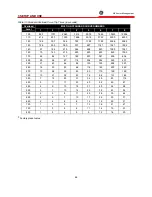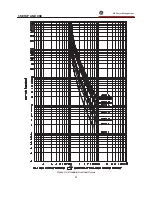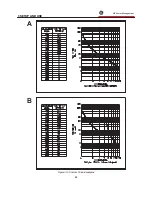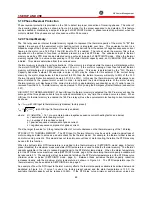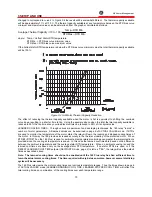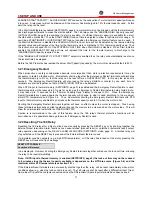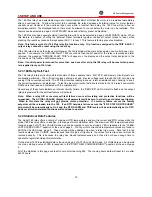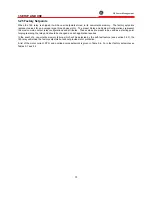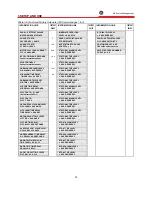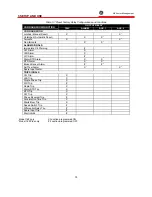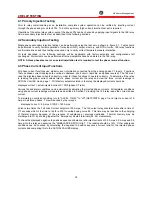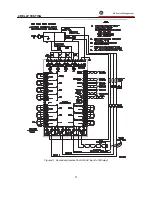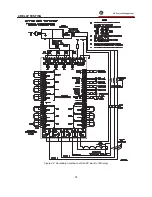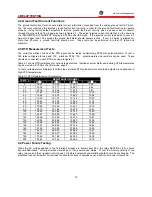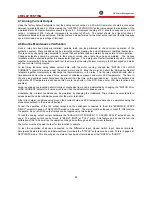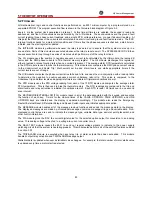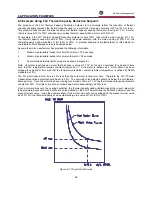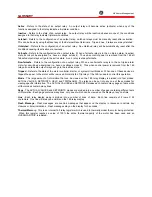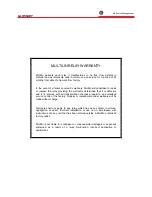
4 RELAY TESTING
g
GE Power Management
80
4.7 Analog Current Output
Using the factory default setpoints to test the analog current output, a 4-20 mA DC ammeter should be connected
between terminals 58 and 59. While viewing the "HOTTEST STATOR RTD" actual value adjust the resistance of the
simulated stator RTD potentiometers shown in figure 4-1. A displayed reading of 0 C should correspond to a 4 mA
output. A reading of 200 C should correspond to an output of 20 mA. The output should be a linear function of
temperature between these extremes. Similar tests can be performed for the other output options (thermal capacity
used, motor load as a percentage of full load).
4.8 Routine Maintenance Verification
Once a relay has been properly installed, periodic tests can be performed to check correct operation of the
protection system. Many conditions can be simulated without creating the actual trip/alarm conditions themselves.
This is done by changing relay setpoints to values that will initiate trips and alarms during normal motor operation.
Changed setpoints should be returned to their proper values when tests have been completed. The Access
terminals must be shorted together to allow setpoint changes. The Emergency Restart terminals should be shorted
together momentarily 5 times before each test to ensure that the relay thermal memory is fully discharged and starts
per hour counter is fully cleared.
To test relay functions using phase current data, with the motor running, change the "MOTOR FULL LOAD
CURRENT" setpoint to a value under the actual motor current. Stop the motor and short the Emergency Restart
terminals together momentarily to discharge the thermal memory in the relay. The trip relay should activate after a
time determined from the overload curve, amount of unbalance present, and motor RTD temperature. The time to
trip at a given overload level should never be greater than the time on the overload curve. Current unbalance and
high stator RTD temperatures will cause this time to be shorter (if the RTD bias and/or U/B bias functions are
enabled).
Larger overloads, representing short circuits or mechanical jams, can be simulated by changing the "MOTOR FULL
LOAD CURRENT" setpoint to a value much lower than the actual motor phase current.
Unbalance trip or alarm conditions can be simulated by changing the Unbalance Trip or Alarm Level setpoints to
values below the actual unbalance present at the motor terminals.
Other trip or alarm conditions using ground fault current data and RTD temperature data can be simulated using the
procedures outlined in the previous sections.
To test the operation of the 169 output relays and the switchgear connected to them the "EXERCISE: XXXXX
RELAY" setpoint in page 6 of SETPOINTS mode can be used. The motor must be stopped in order for this function
to operate. Any or all of the output relays can be toggled using this setpoint.
To test the analog output current hardware the "ANALOG OUT FORCED TO: XXXXXX SCALE" setpoint can be
used. The output current can be forced to "ZERO", "MID", or "FULL" scale. This feature can be used to test the
calibration of the 169 as well as the operation of any device through which the current is flowing.
The motor must be stopped in order for this function to operate.
To test the operation of devices connected to the Differential Input, Speed Switch Input, Access terminals,
Emergency Restart terminals, and External Reset terminals the "STATUS" setpoint can be used. This is in page 6 of
SETPOINTS mode. This line will give the status of each pair of terminals as either "OPEN" or "SHORT".
Содержание 169
Страница 12: ......
Страница 14: ...2 INSTALLATION g GE Power Management 8 Figure 2 2 CT Dimensions ...
Страница 17: ...2 INSTALLATION g GE Power Management 11 Figure 2 4 Relay Wiring Diagram AC control power ...
Страница 19: ...2 INSTALLATION g GE Power Management 13 Figure 2 6 Relay Wiring Diagram Two Phase CTs ...
Страница 20: ...2 INSTALLATION g GE Power Management 14 Figure 2 7 Relay Wiring Diagram DC Control Power ...
Страница 28: ...2 INSTALLATION g GE Power Management 22 Figure 2 10 169 Drawout Relay Physical Dimensions ...
Страница 29: ...2 INSTALLATION g GE Power Management 23 Figure 2 11 169 Drawout Relay Mounting ...
Страница 30: ...2 INSTALLATION g GE Power Management 24 Figure 2 12 169 Plus Drawout Relay Typical Wiring Diagram ...
Страница 31: ...3 SETUP AND USE g GE Power Management 25 Figure 3 1 Front Panel Controls and Indicators ...
Страница 73: ...3 SETUP AND USE g GE Power Management 67 Figure 3 2 Standard Overload Curves ...
Страница 74: ...3 SETUP AND USE g GE Power Management 68 A B Figure 3 3 Custom Curve Examples ...
Страница 83: ...4 RELAY TESTING g GE Power Management 77 Figure 4 1 Secondary Injection Test Set AC input to 169 relay ...
Страница 84: ...4 RELAY TESTING g GE Power Management 78 Figure 4 2 Secondary Injection Test Set DC input to 169 relay ...
Страница 88: ...5 THEORY OF OPERATION g GE Power Management 82 Figure 5 1 Hardware Block Diagram ...
Страница 90: ...5 THEORY OF OPERATION g GE Power Management 84 Figure 5 2 Firmware Block Diagram ...

